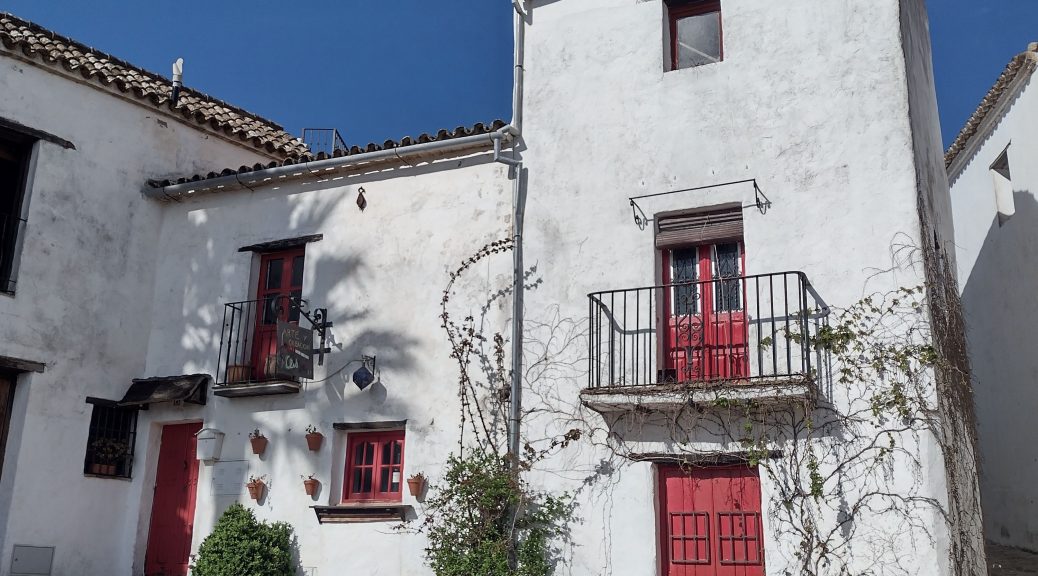
Castellar de la Frontera: orange blossom and hand-painted scarves
The smell of jasmine and orange blossom fills the air. I think how lovely it must be when the flamenco bar and restaurant are open, although secretly I’m glad they aren’t and that I’ve arrived in time to wander round the village in pleasant solitude.
Castellar de la Frontera has changed since I last visited it 20 years ago. I have a vague memory of a cold and cloudy February weekend afternoon and stalls selling tie-dyed baggy trousers inside the castle walls. It seemed to take forever to get here that day winding along an old road passing the reservoir. Today the journey was different. It’s a beautiful spring day, the road brought me here quickly and the castle has been converted into a hotel.
On the way up the hill into the village, the Venta Carmen with its tables outside and lovely views of the mountains tempts me in for second breakfast. I park on the side of the road and wander back on foot. The panadero hasn’t arrived yet with the freshly baked 24-hour bread and all they can offer me is normal white bread. I’m not actually that hungry yet so, I decide to continue walking towards the castle intending to return at mid-morning for breakfast when the fresh bread has arrived.
An unexpected encounter
A lady pops out of a pathway and I take the opportunity to ask if I can walk from here to the village.
“Yes, of course. This is the way. You can come with me if you like.” She says in perfect Spanish but with a slight accent that makes me aware that it’s not her first language. “I’m going to work.”
We walk up the road and as we go I discover that she’s German, her name is Ursula and she has lived in the area for years. We walk up the quiet winding road with the sun, already warm, on our backs. A cyclist rides past us. At the end of the road, the castle appears before us; its grey stone standing out against the blue Andalusian sky.
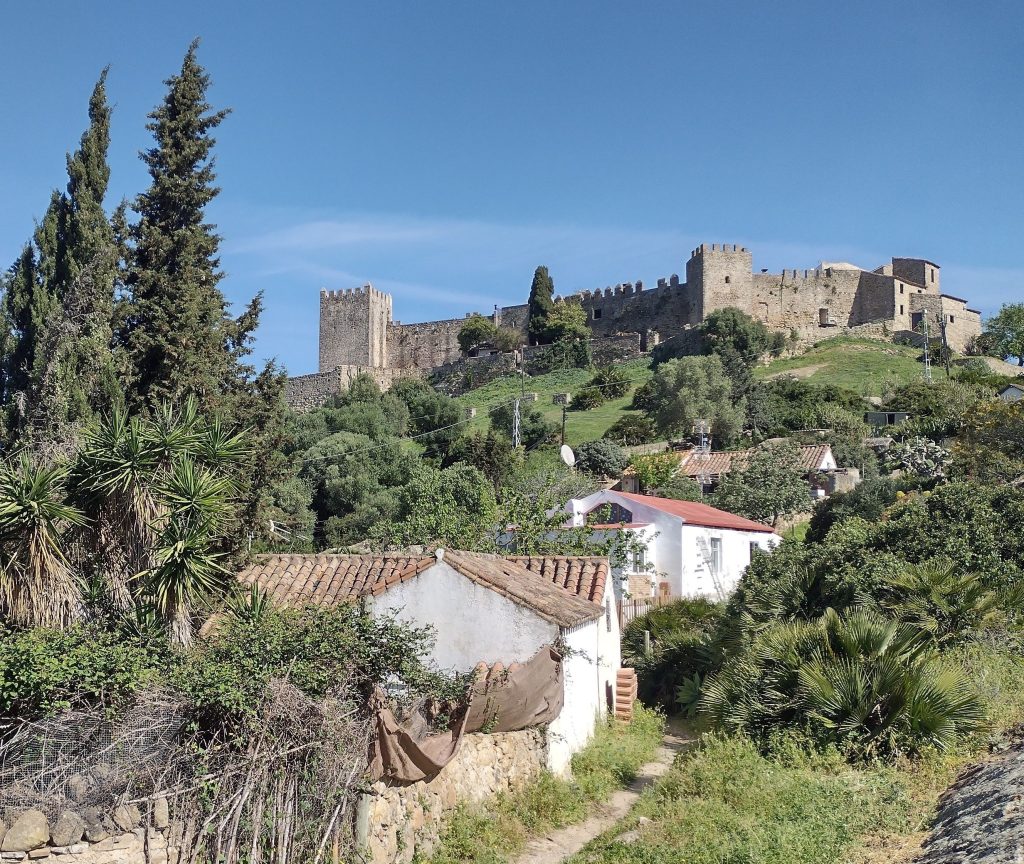
Leaving the tarmacked road, we turn onto the cobbled footpath that leads us inside the mediaeval walls of the village. Apart from our conversation, all is quiet. In just a couple of minutes we’ve arrived at the shop that Ursula runs in the tiny village. I leave her to set up promising to return shortly.
The village
I wander around the village taking in the views over the reservoir and the smell of orange blossom. I notice how well-kept the houses are. Many of them proudly wear casa rural signs letting me know they are officially registered by the Junta de Andalucia as guest houses. There’s hardly anyone around and I wonder how many people actually live here inside the walls or if they have all moved to Castellar El Nuevo; the modern functional and purpose built town that’s about a 20-minute drive away with schools, shops, banks and all its other mod cons.
I say hello to the cyclist who is now perched on the parapet admiring the view whilst he drinks water. I nip into the hotel and contemplate having a coffee outside at one of the tables. The hotel is clearly open but there’s no one around to order from, so I carry on meandering, passing under the arch and out onto the tiny square.
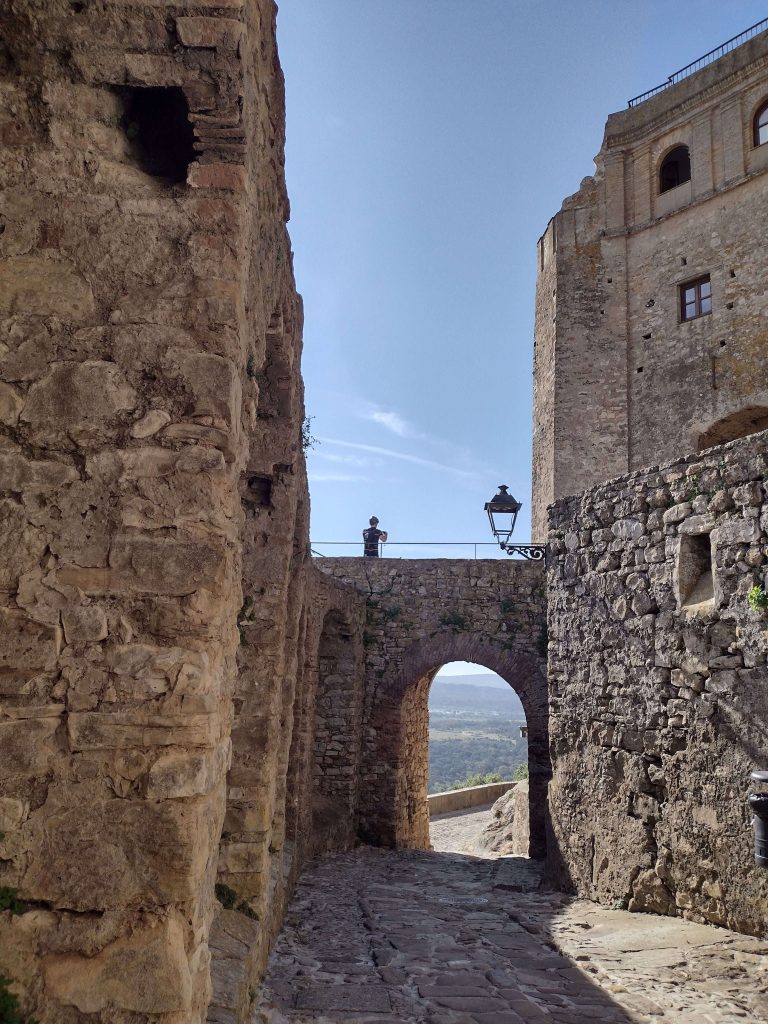
Hand-painted scarves
15 minutes later, I’m back outside Ursula’s shop. A colourful arrangement of herbs and spices in a basket lures me over. Dried herbs and local plants for herbal tea. Ursula has a talent for creating eye-catching displays and I am drawn into the shop by the colours and cheerful arrangements. Ursula greets me warmly. This time she switches to English and I wish that I could communicate half as well in her native language.
Inside it’s cool and dark. As Ursula serves a customer, I notice brushes and tubes of paint laid out on the side. A scarf is stretched out on a rack. As I turn around, a bright blue scarf with two large goldfish catches my eye. It’s hanging amongst a colourful array. Then I spot a larger scarf with a drawing of the village. It’s stretched out on a rack. The village is sketched out and bits of it have been painted in. I realise that Ursula is hand painting the scarf.
“Yes,” she says in answer to my question when the other customer has left. “I paint them all.”
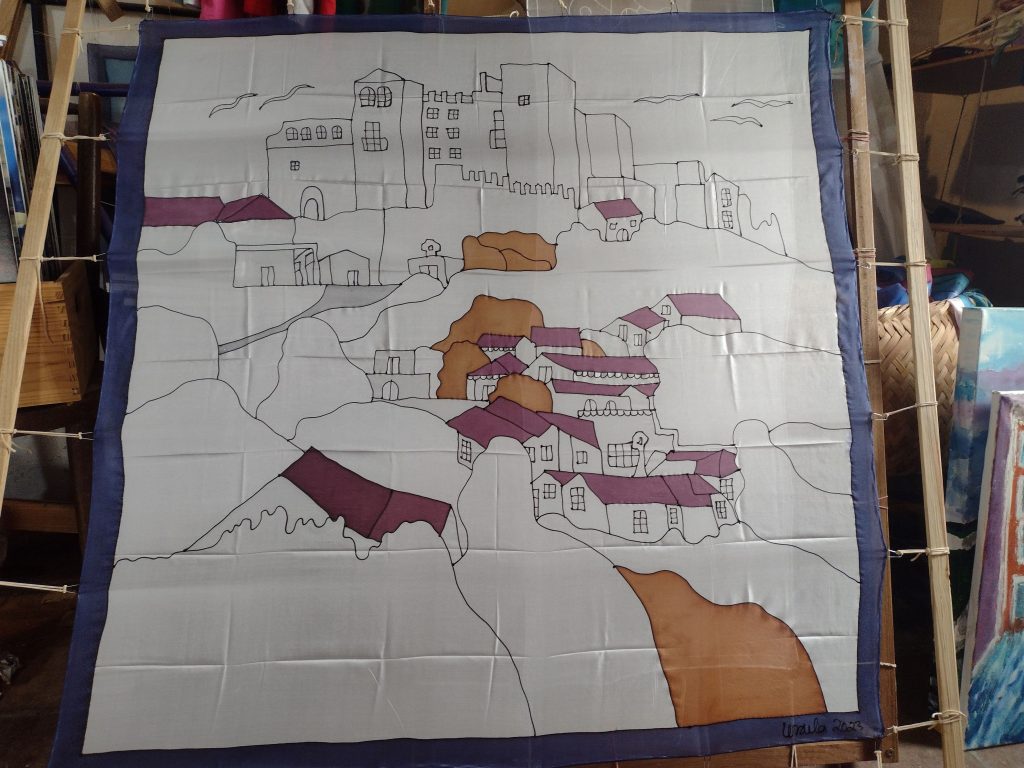
Ursula shows me the sign she’s hand painting as part of her contribution to Castellar’s attempt to educate its visitors. It’s a list of commandments instructing tourists not to litter, pick the plants or let their dogs run loose.
Sustainable tourism
I ask if the amount of casa rurales, along with the hotel, means the village is more of a holiday resort than a village.
“No,” she says emphatically, “Those are the visitors we want. The ones who come to stay for a while and enjoy the peace and quiet. They have time for conversation and to really get to know us. What we don’t want are the coaches. Last week three coaches arrived at the same time and it was too much. The tourists wander around for 30 minutes, pick the plants and leave their rubbish. The coaches got stuck trying to turn around to go back down the hill. It was a nightmare.”

She raises her eyes to the ceiling. “With the guest houses and the hotel, we have more than enough and we don’t want bloody coach loads.” I smile at her cursing. It’s not easy to swear so that it sounds natural in a second or third language but she’s managed it perfectly.
“We want the sort of visitor who respects the village and enjoys the way of life. Not a group of people who are noisy, spend 30 minutes here and get back on the bus.”
A story from Ursula
While I am not surprised by Ursula’s sentiment, I am impressed. As a small business owner who depends on visitors, it would seem to make sense to have more footfall, but, wisely, she’s more interested in the bigger picture and clients who stop to have a chat. She tells me a story about a lady who bought one of her scarves 15 years ago.
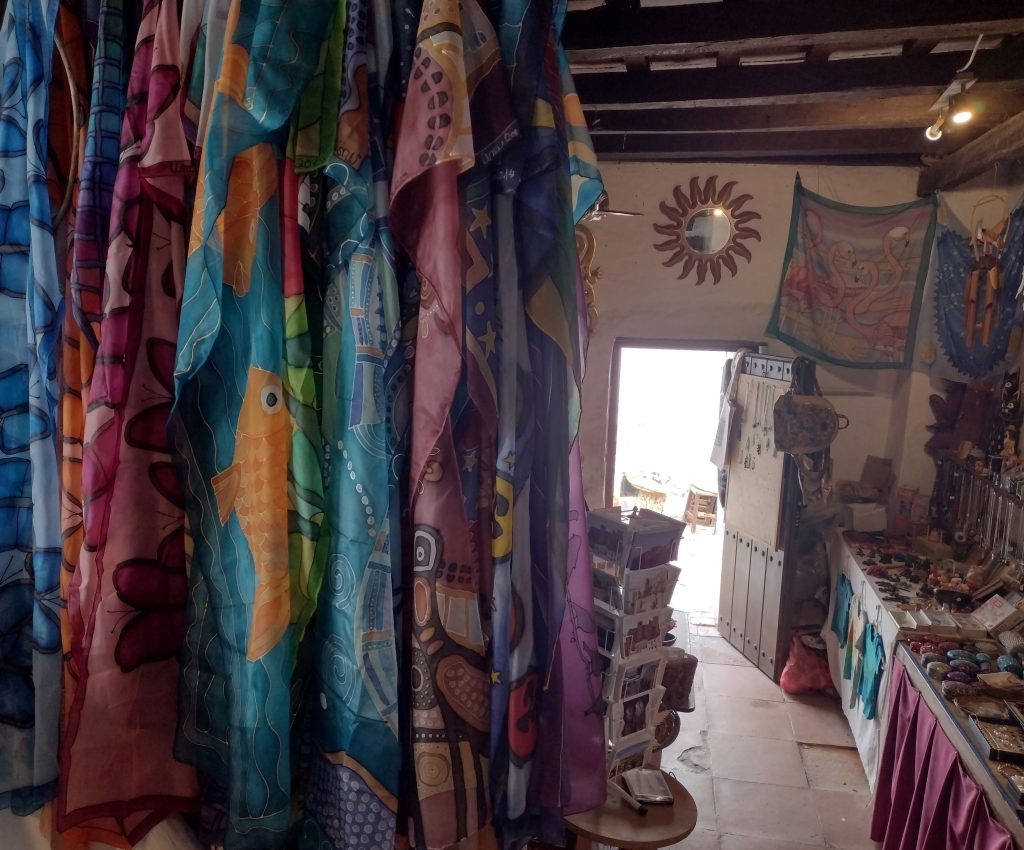
“The lady was Japanese but lived in Austria. That’s why I remembered her so well. She sent me an email recently asking if I was still alive and still painting scarves. It turns out her scarf had faded after so much use and she wanted another one. She sent me photos and from the photos, I painted her a new one. I sent her photos of my other designs and she bought a couple more. I posted them to her. All the way to Austria. 15 years later.”
Ursula clearly loves the story and it has made an impression on her that a client has come back to her after so many years.
Choosing a present
I remember that I need a birthday present and I start to look through the scarves. Ursula helps me. Struck by a green one with red tulips, I think I’ve made up my mind. Then Ursula points out another one with the village landscape. Ursula has signed and dated them all. The tulips were painted in 2019 but the village landscape with the castle was painted this year. I like the idea that it is signed with the current year. It seems to be perfect for a birthday present. I try them both on. Maybe I am more convinced by the tulips because the colours are livelier, but the idea of the castle appeals to me. It tells me a story.
I decide on the scarf with the castle and we go outside to find a signal for the card machine. We walk around the village. Ursula leaves the shop unattended without a second thought. We end up outside the flamenco bar and the little restaurant. Both are still closed. Ursula rests the card machine on a sherry barrel that’s been converted into a table and we wait for it to take my payment.
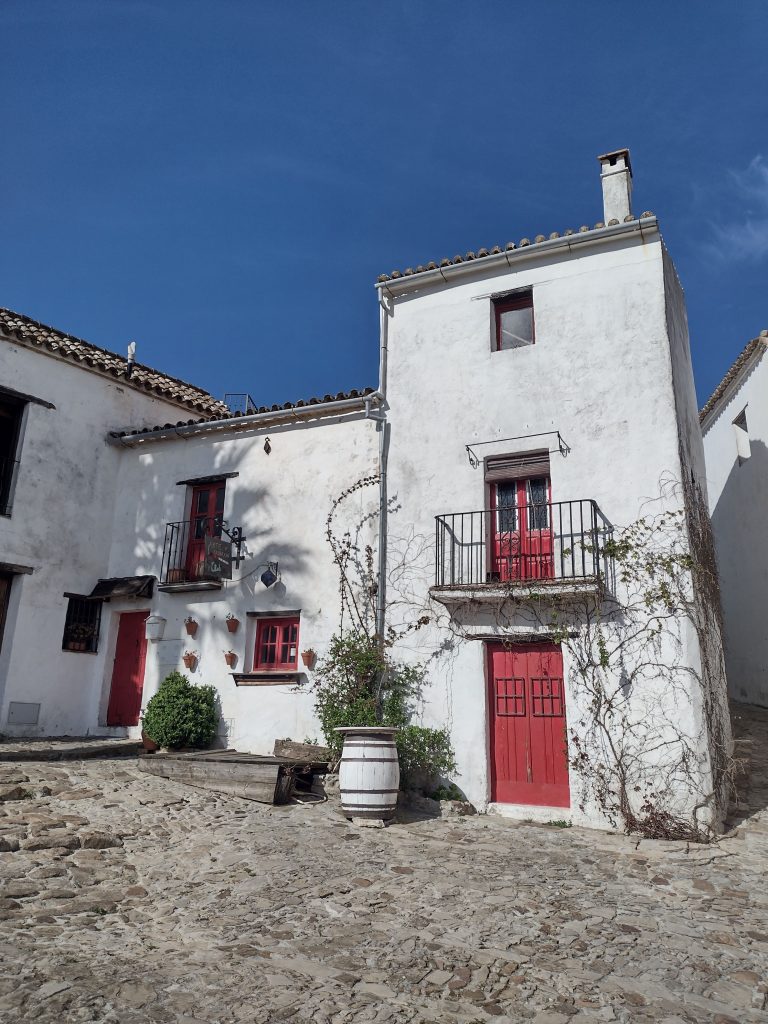
Later, I wonder if, perhaps, 20 years ago she had been amongst the people selling tie-dyed baggy trousers from a stall within the ruins of the castle.
Thoughts over lunch
I ask Ursula where to eat and she tells me at the Venta Carmen they ‘cook’. Knowing it’s homemade, I’m happy to go back there. I wander around the outskirts of the castle. It’s warm. Temperatures are higher than normal and despite the lack of rain this winter, the landscape is green. I know, in the coming heat, this won’t last long.
I make my way back down the hill and go into the restaurant. There’s hardly anyone there although I’ve been told twice now that it gets very busy from 1pm onwards. It’s nearly 12.30 and I’m no longer in the mood for toast, so I cast my eye over the colourful tapas on the bar. I choose papas aliñadas and pulpo and take myself outside to sit at a long table under a tree overlooking the stunning views. A palm tree sways in the wind; its leaves sound like the sea gently lapping on the shore.
My tapas arrive and I ask for the freshly baked bread that I know will have arrived by now. After my walk, the food and warm air relax me even more. I enjoy the company of my notebook and pencil as I take a moment to scribble down Ursula’s story of her Japanese-Austrian client before I forget it.
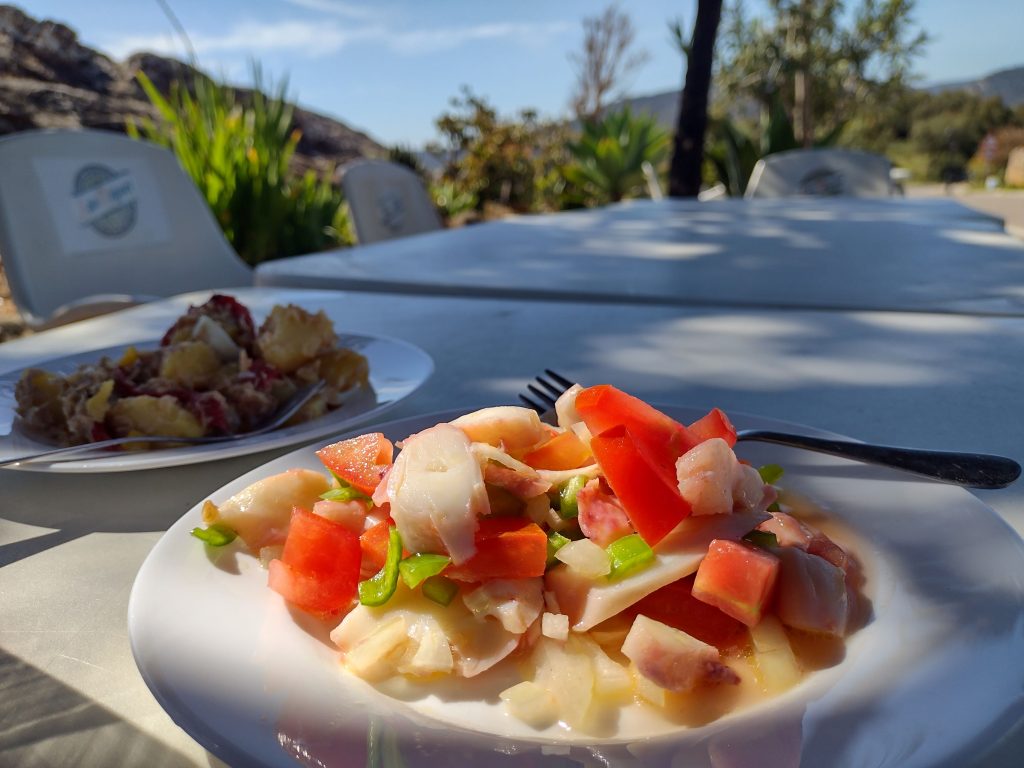
A moment of doubt
Suddenly I wonder; should I have chosen the green scarf with the lovely red tulips after all?
Oh well, I can always call and ask if it’s still there. Ursula might even post it to England for me. And, who knows? One day she might tell my story to her future customers about how I couldn’t decide which scarf to take and later called her in search of the bright green one with the red tulips.
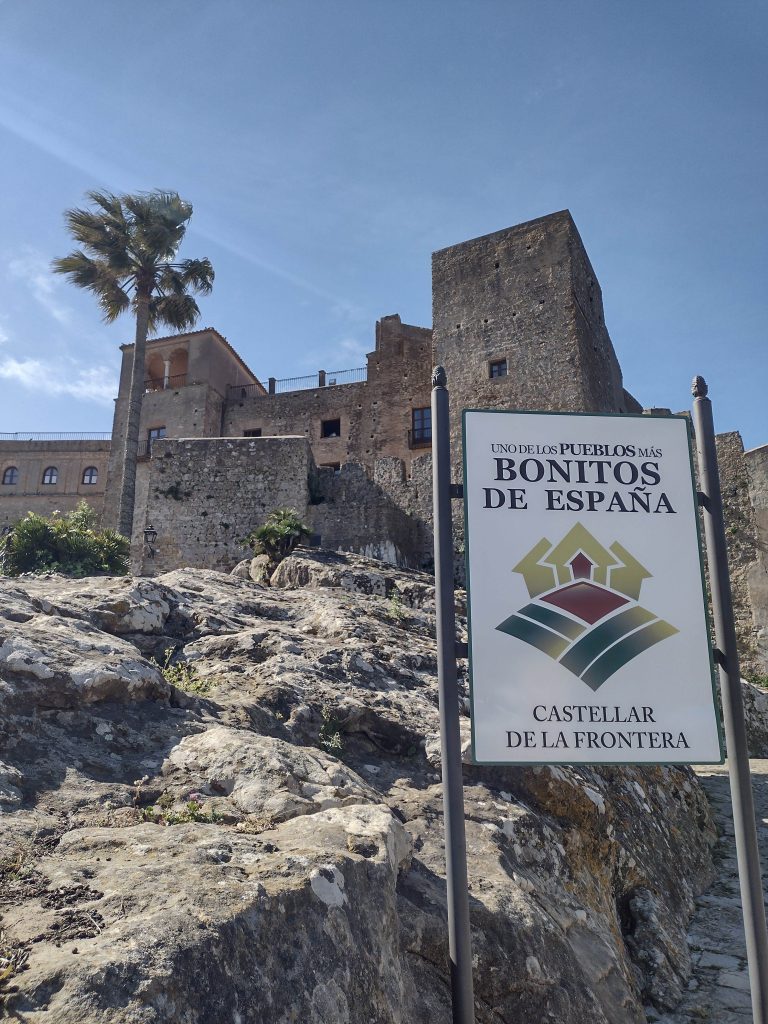
Practical information
Castellar de la Frontera is in the province of Cádiz in Andalusia, SW Spain. It’s approximately 40 minutes by car from Gibraltar or Estepona. There’s plenty of accommodation including house rentals and the hotel. I didn’t see a food shop (although this doesn’t mean there isn’t one), so you might want to take supplies with you or stop off at Castellar El Nuevo on the way if you’re planning to stay. It’s advisable to park in the car park on the way up and walk.
A public toilet is available at the tourist information office. In the surrounding areas and at the bottom of the hill, near another restaurant there are some lovely walks including the Ruta de la Mariposa (the butterfly walk). There’s a viewpoint at the reservoir from which I’ve been told, the sunsets are quite something. To get there, go over the bridge at the bottom of the hill near the restaurant and follow the road round. Please note that out of season, restaurants and bars may not be open on certain weekdays. If you want to eat at Venta Carmen, you may want to get there early as it did start to get busy at 13.30!